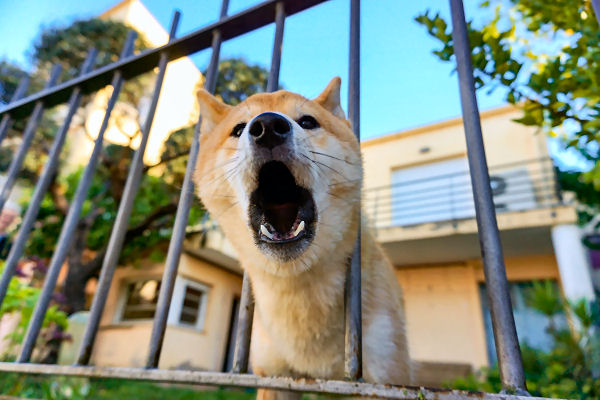“How do I get my dog to stop barking?” is always in the top five questions all trainers get.
In response to our last tip “Be There,” we got some questions about the story with the barking dogs. The immediate “fix” was to restrict access to the windows where the dog barks. We talked about how dog learning never happens if you’re not there to teach.
So we have to turn the question around a little. You have to put yourself in the picture. It’s “How do I teach my dog to stop barking?” You’re the one causing the change.
Stop Barking game

Recognizing your dog’s barking triggers is the first step in changing the behavior. Is there a particular time of day that your dog barks? If so, what’s going on at that time? It could be any number of things, from kids on their way to school, to the postal carrier, to delivery people.
If you really want the barking to stop, restrict access to the area/room/window where the dog finds the trigger. This can be as simple as closing the blinds, or putting up a gate. It’s a temporary restriction, until your dog learns “Quiet!”
If there is a regular time your dog barks, be ready in advance. Make sure you have your clicker and really, really yummy treats. If your dog is a habitual barker, he or she is happy when barking. Turning it around will require a really terrific reward.
When your dog lets out a bark, get excited and move toward the window where the dog is barking. “What’s there, Fido?” “What do you see?” Don’t look at your dog, look outside. Chances are this will confuse your dog, since he or she is used to you paying attention to them, instead of what’s outside.
Focus on you
When you think about it, that’s pretty true, isn’t it? When your dog barks, you’ve probably immediately paid attention to the dog, not what they’re barking at. An unintended consequence is that you’ve rewarded your dog with your attention whenever they bark. Which means they’ve learned to bark to get your attention. (Next week we’ll talk about Barking for Attention.)
When your dog looks at you in his confusion, click and reward. “Good quiet!” And walk away from the window. Invite your dog to come with you, rewarding for coming away. If they don’t keep you company, run away from the window. When your dog catches up to you, give him a treat, or if your dog’s favorite reward is a toy, play a quick game of tug.
That’s all there is to the game – getting your dog’s attention on you instead of the barking trigger. If you have to get between your dog and the stimulus, do it. When Hope’s French Bulldog Torque started barking incessantly at the Husky two doors down, she stepped between Torque and the fence, talking to him to get his attention. As soon as he glanced at her, he got a click and a cookie. A really, really good cookie. Most of the time he just glances at the Husky now. And then runs over to Hope for a treat.
Control the situation
In Torque’s case he went out in our own fenced backyard on leash until he learned the game. Training games only work if both of you are there and paying attention. This wasn’t a game Torque really wanted to play, but he got it.
Your dog will, too. If it happens that your dog starts barking when you’re not prepared, do anything to interrupt the behavior and reset your dog’s focus. You know your dog’s magnets. One of our dogs would come running whenever he heard a M & Ms package rattle. (He only got one – we asked the vet for permission.) Another dashes over when he hears the treat cabinet. Use what you know about your dog!
Allowing the barking to continue just solidifies the habit. And, as you know, habit is one of the most powerful forces in the universe. Changing an entrenched behavior will take time, but it can be done with patience and consistency.
